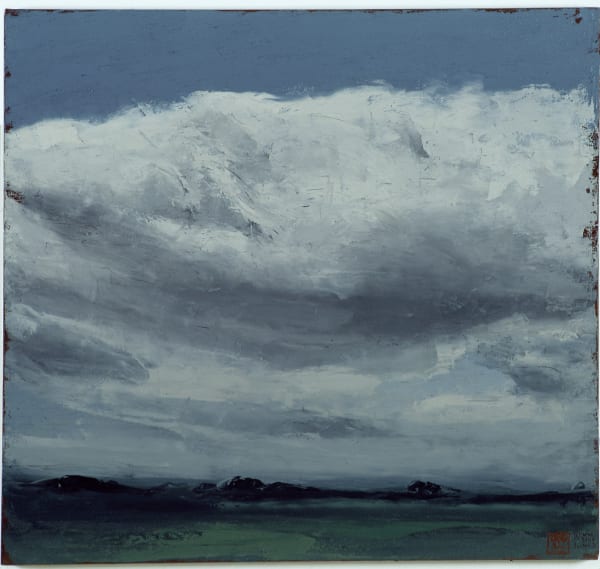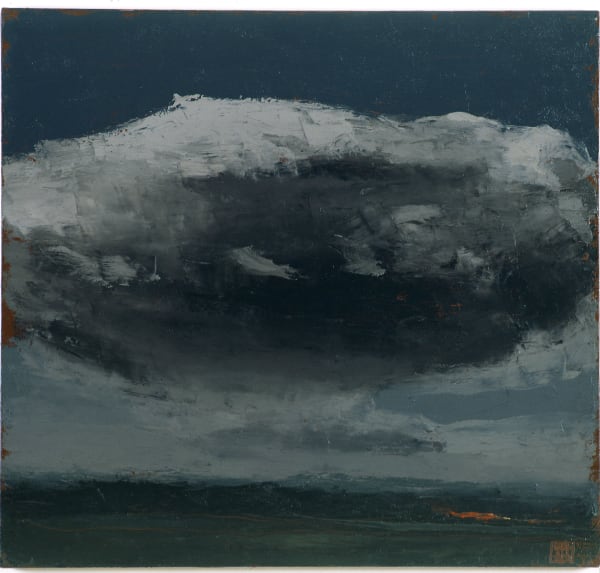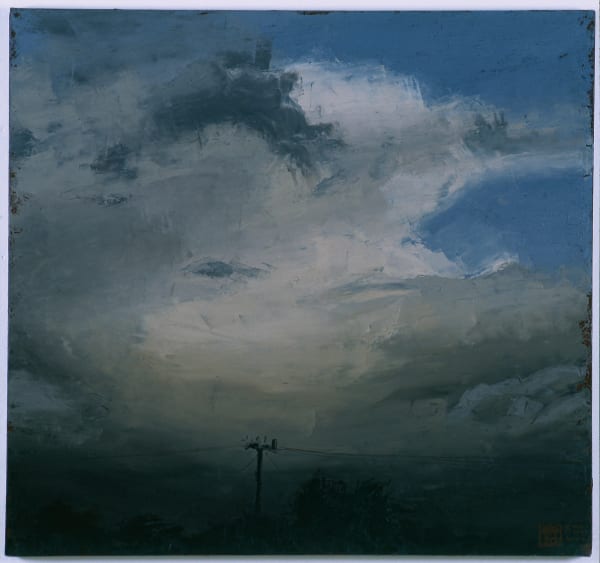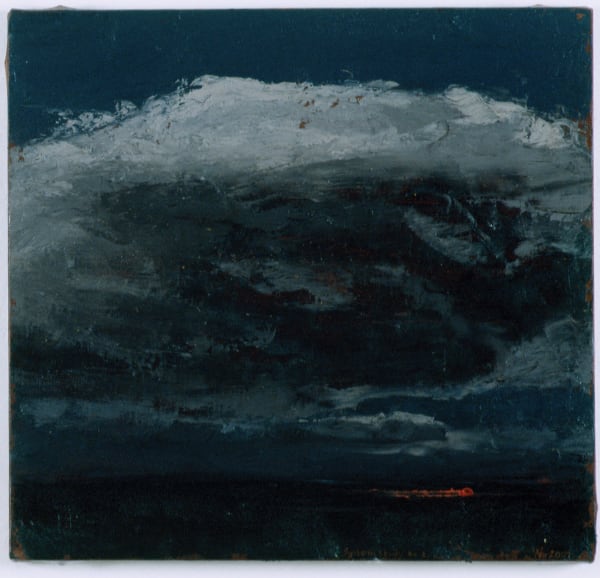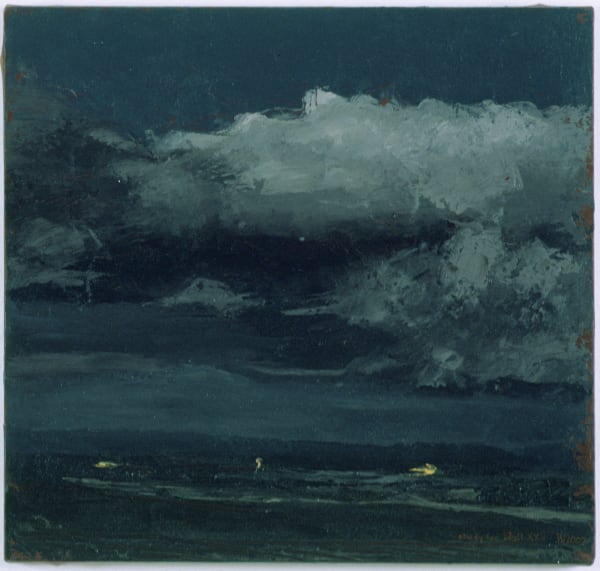Vapour Trails
To be confronted with a room full of John Constable’s oil sketches, as I was in March last year, is to be at once exhilarated and intimidated. What breathtaking freshness these have: nature crystallised in exuberant paint. The exhibition was Constable: Impressions of Land, Sea and Sky at the National Gallery of Australia in Canberra, which placed particular emphasis on his outdoor sketches that I have loved for so long. I first fell under the spell cast by Constable’s oil sketches as a graduate printmaker in 1987. It was the cloud studies from Hampstead Heath painted in 1821 and 1822 that interested me most. To a young artist interested in nature, these paintings of clouds seemed exciting and of contemporary relevance. Henceforth I abandoned the printing press and commenced this new craft of illusion; painting.
Experiencing Constable after a 20 year interval reminded me of the power of the sky, of the power it has to solicit emotional responses from us. Clouds are possibly the most subjective of all ‘natural’ scenery: we respond with spontaneous emotion to a threatening sky, with both rapture and fear.
The paintings in this exhibition are the product of 12 months ceaseless searching for the fleeting moment when the sky swells with meaning. I have found the flux of clouds to be frustrating; most of the time I look up to see only chaos in the cloud forms - not meaningful enough to paint - merely indicating the approaching weather. But when the clouds do ‘form up’ in my eyes they become a field on which I can project concerns about climate, nature and culture. Such portentous moments are naturally rare.
Aside from these conceptual and compositional concerns, one of the challenges I thought I would face was the limited scale imposed by the practicalities of transport. Painting the sublime landscape three feet square is demanding when you really want a six foot canvas to convey the magnitude implied – size really is meaningful, I thought. In retrospect, I feel that this limitation actually expanded my vision; I found I had to dig deeper into my reserves of concentration and painterly skill than I ever had before. I am still a little bemused with this unexpected discovery. Somehow my intense concentration caused a distillation of the image, a kind of dehydration of nature just awaiting the viewer’s imagination to allow the image to swell up again.
Above all I have sought to impart my feelings of uneasiness about the changing weather in these paintings. I want to convey this latent anxiety, of anticipation of something important about to happen. It is for the audience to speculate on what that event might turn out to be.
Philip Wolfhagen
April 2007
“I’ve spent all summer looking for the perfect cloud,” says Philip Wolfhagen. He’s speaking in the cavernous space of his studio, a place pungent with the paint smells of linseed and beeswax, and vigorous with creativity. As he talks, he gazes outside, eyes directed at the sky, where cotton candy mounds swell in a deep Autumn blue. “I’ve come very close, but I haven’t found it yet. I’m still looking,” he says.
Today, there are almost as many clouds in the artist’s studio as there are outdoors, as he prepares his newest collection of canvases for exhibition: all of them clouds anchored in paint. “I captured this one in the Spring,” says Wolfhagen, pointing to a canvas on the easel, “but it still wasn’t the ideal cloud. It all started when I was waiting for my daughter to get off the school bus one day,” he says. “This wonderful cumulonimbus anvil drifted past, and much to her annoyance, we took off and chased it.” Over months the artist’s studio filled with photographs of cloud banks and his canvases with bright, vaporous wisps and piles of ominous grey.
For all this talk of the ethereal, Wolfhagen is no head-in-the-clouds artist. One of Australia’s best known painters, and probably its foremost proponent of landscapes, he enjoys a status most artists dream of. Exhibitions of his work routinely sell out, with buyers putting in requests often before the gallery doors have opened. The waiting list to buy a piece of the Wolfhagen magic runs to hundreds. This, from a bare-boards-and-beams studio in a small town in a land that’s by any description peripheral: Australia’s island state of Tasmania. Yet this wild island at the edge of the world represents both Wolfhagen’s roots and his inspiration. And it’s a better place than most for cloud spotting.
“When I was thinking about material for this new show, I began to consider clouds on many different levels,” says Wolfhagen. Exhibiting for the first time internationally, the artist was aware of the need to produce scenery more familiar to audiences than his often bleak Tasmanian landscapes, so skyscapes became the theme. “Clouds are an international visual language,” he says. “Everybody can relate to them. They’re a piece of nature that even urban dwellers can spy between the skyscrapers in a city.” Wolfhagen’s clouds also express ephemerality. “The wonderful thing about clouds,” he says, “is that they’re in a state of flux, continually massing and changing, so it’s about capturing moments.”
The paintings speak bitter-sweet truths about the fleetingness of perfection, about the swift passage of time, and about mortality. Memento mori is the name one canvas bears, Remember you must die, and in it, a gloomy cloudmass swells in a shape ominously like that of a skull. The paintings, some of them great looming thunderfronts, also bear the portent of a coming storm. “They do have a sense of ominousness, and that’s an environmental message,” says Wolfhagen. Whether these are the storm fronts of global warming, or boiling mushroom clouds, the artist intends them to stand as a warning against present and future environmental disaster. “I wanted to express what’s now a global concern,” he says.
These are themes that come naturally to Wolfhagen. The artist’s childhood realm was a remote sheep farm in the centre of Tasmania. “The landscape was everything where I was born,” he says. He talks of tickling trout in streams, working with sheep, and roaming the dry grasslands, intensely aware of connection to the land. Here the changing seasons and the cycles of life were as constant as the vastness of the overarching sky. Studying at the University of Tasmania where he began his artistic career as a printmaker, and then at the College of Fine Arts at Sydney University, Wolfhagen describes his early attempts at painting as “inept”. No particular epiphany brought him to landscape painting though he cites the nostalgia he felt for his Tasmanian homeland, while working in inner-city Sydney, as an inspiration. A move back to rural northern Tasmania, where he still lives and paints, proved to be the wellspring for Wolfhagen’s creativity, and the source of the spare, romantic landscapes on which his reputation is built.
In his cloud-strewn studio, the artist elucidates. “My painting is about connectedness with place and connection to the natural world. I’m not an explorer artist, I don’t conquer new lands. It’s a way of articulating my love of place, and expressing concerns about the future, as well as trying to convey some universal human themes.” In Wolfhagen’s depictions of Tasmania’s windswept Central Plateau, his sombre dunescapes, luminous sea scenes and vistas over pastoral lands, just as in his cloud studies, there are recurring leitmotivs of mortality, transience, and the passage of time. “The landscape is a great vehicle for conveying these concerns,” says Wolfhagen, “because living close to nature is a very clear way to notice time and the changing seasons – to observe the poignancy of moments, and how things pass. Culturally, we have become so far away from the natural world and so disconnected from what’s real. As a painter, I see my raison d’etre as being a go-between between the high culture and the natural world.”
To do that from Tasmania is important for Wolfhagen. At forty-two degrees South, surrounded by sea, and buffeted by the prevailing Roaring Forties, the island has a raw, untamed feel that speaks of separateness, of being apart. To the south the only landmass is Antarctica, two weeks’ sea journey distant; the West Coast bears the brunt of waves that have circled the planet. Almost a third of the island is wilderness, and there is a strong environmental conscience. Culturally also, this island feels different to the Australian mainland: quieter, humbler, but also wilder and more creative perhaps. It’s a quality Tasmanians (all 480,000 of them) like to call “Islandness”: a kind of defiant self-sufficiency born of years of hardship and making do. This has also spawned a disproportionately vibrant arts scene, of which Wolfhagen is one of the brightest stars.
In describing Tasmania’s physical environment as inspiration, Wolfhagen is eloquent: “Wind, wind, wind. Water, beautiful rivers coming out of the mountains, the ocean, the trees, the humus smell of rotting gum trees and ti tree, the feeling of connection to Gondwana - the ancient Southern Continent. Being above the tree line in mountain heath…such an ancient landscape. And ice. I often think of ice, the way it has shaped the land.” Living on this remote island - on the periphery - is important to Wolfhagen also for the reflective viewpoint it allows. “The peripheral vantage point is a good place from which to view the world, particularly for an artist,” he says. “Standing apart helps you to know where things come from, and what’s real.”
Wolfhagen’s Tasmania has a strong historical viewpoint too. For him, connection to place is also about connection with the layers of time. Tasmania was explored by the French at the end of the 18th Century, then British colonisers and convicts from 1804. The artist’s family – which he traces back 500 years - came to the island in the 1860s, and Wolfhagen grew up in a house built as soldiers’ barracks in 1824. He works in a studio that was once a convict-built flour mill, the two foot thick brick walls and hand sawn timbers a constant reminder of that past. “I feel deeply connected to 19th century Tasmania,” he says. The artist cites one of his early inspirations as the convict artist William Buelow Gould, and his landscapes owe an undoubted debt to Constable. “Constable was making his first impressionist paintings in 1802, which was around which around the time Hobart was settled. I love the parallels that history provides. It helps me to understand what I’m doing,” he says. “I look at Tasmania in some ways though the eyes of 18th century painters, and see the wonderful Arcadian hope they had for the place. My paintings try to acknowledge that.”
There is a darkness in Tasmania’s past that’s palpable in Wolfhagen’s work also. The island’s Aboriginal inhabitants and their millennia-old culture were decimated within the first decades of colonial subjugation. Likewise, the island’s legendary emblem, the Tasmanian tiger, was hunted determinedly to extinction. Perhaps the emptiness of some of his landscapes express an absence of what once was – a feeling that’s often tangible in Tasmania. Then there are the dark layers of convict suffering, a historical spectre that still looms large in the Tasmanian psyche.
Watching Wolfhagen paint is to understand much about his art. He keeps to a strict regime of five hours in the studio each morning, six days a week, accompanied by a musical soundtrack that ranges from Handel to Beethoven to Britten. By his easel is an expansive palette of colours – hand-ground oils mixed with beeswax – that is his crucial point of reference. Today the palette is the colour of cloud base, which the artist blends swiftly, encouraging graininess of texture. He works quickly, trowelling on the paint with a knife, making juxtapositions between colours with hard lines, creating an effect on the canvas like facets on a stone.
Wolfhagen rarely paints in the environment: immersing himself in it, instead, prior to painting, and using the camera as his sketching tool. The studio is his place for intellectual reflection, and this is where meaning is derived. “I don’t paint according to a theory,” the artist explains. “I paint in a way that the message comes out in the process.” And it is the process itself that is the very core of his work. “The creative process is pretty agonising for me,” he says. “I can go through months of disappointment when I struggle with the elements, and then suddenly, like alchemy, something quite intangible makes them fall into place. It’s when things reach a kind of stillness and alignment, as if they’ve always existed, that’s when I know I’ve done good work.”
Landscape, it has been argued, is a human construct: a notion that prevails only because of the human need to depict, order and contain it. In this sense, landscape art is very much a reflection of the internal. “My desire to paint is certainly a way of ordering and aestheticising the world,” says Wolfhagen. “Landscape is such an amorphous subject matter, and trying to order it is a way to try to find meaning.” Wolfhagen’s ability to get to the core – to convey the stillness and balance at the very centre of what he sees – is perhaps what makes his work so sought after. “The wellspring of my inspiration is internal,” he says. “My paintings are as much about nature and about place as they are about the interior world. They are the deepest expression of the interior. That’s why painting is the best thing I can do to improve the world,” he says. “It’s a pretty romantic idea.”
A collection of clouds, too, is certainly a romantic concept. But these pictures are infinitely more than just depictions of nature and beauty - more than oil paints and water vapour. They are about what it means to be human.
Gabi Mocatta
April 2007
-
 Philip WolfhagenMemento mori II , 2006oil and beeswax on linendiptych: 180h x 192w cmSold
Philip WolfhagenMemento mori II , 2006oil and beeswax on linendiptych: 180h x 192w cmSold -
 Philip WolfhagenMemento mori I, 2006oil and beeswax on linendiptych: 180h x 192w cmSold
Philip WolfhagenMemento mori I, 2006oil and beeswax on linendiptych: 180h x 192w cmSold -
 Philip WolfhagenA cruciform landscape, 2006oil and beeswax on linendiptych: 180h x 192w cmSold
Philip WolfhagenA cruciform landscape, 2006oil and beeswax on linendiptych: 180h x 192w cmSold -
 Philip WolfhagenNew delirium I , 2006oil and beeswax on linen96h x 103w cmSold
Philip WolfhagenNew delirium I , 2006oil and beeswax on linen96h x 103w cmSold -
 Philip WolfhagenNew delirium II , 2007oil and beeswax on linen96h x 103w cmSold
Philip WolfhagenNew delirium II , 2007oil and beeswax on linen96h x 103w cmSold -
 Philip WolfhagenNew delirium III, 2007oil and beeswax on linen96h x 103w cmSold
Philip WolfhagenNew delirium III, 2007oil and beeswax on linen96h x 103w cmSold -
 Philip WolfhagenIdyll XXII, 2006oil and beeswax on linen96h x 103w cmSold
Philip WolfhagenIdyll XXII, 2006oil and beeswax on linen96h x 103w cmSold -
 Philip WolfhagenIdyll XXIV, 2007oil and beeswax on linen96h x 103w cmSold
Philip WolfhagenIdyll XXIV, 2007oil and beeswax on linen96h x 103w cmSold -
 Philip WolfhagenIdyll XXV , 2007oil and beeswax on linen96h x 103w cmSold
Philip WolfhagenIdyll XXV , 2007oil and beeswax on linen96h x 103w cmSold -
 Philip WolfhagenSystem study no.4, 2007System study no.446h x 49w cmSold
Philip WolfhagenSystem study no.4, 2007System study no.446h x 49w cmSold -
 Philip WolfhagenSystem IV, 2007oil and beeswax on linen96h x 103w cmSold
Philip WolfhagenSystem IV, 2007oil and beeswax on linen96h x 103w cmSold -
 Philip WolfhagenSystem V, 2007oil and beeswax on linen96h x 103w cmSold
Philip WolfhagenSystem V, 2007oil and beeswax on linen96h x 103w cmSold -
 Philip WolfhagenSystem VI, 2007oil and beeswax on linen96h x 103w cmSold
Philip WolfhagenSystem VI, 2007oil and beeswax on linen96h x 103w cmSold -
 Philip WolfhagenSystem VII, 2007oil and beeswax on linen96h x 102w cmSold
Philip WolfhagenSystem VII, 2007oil and beeswax on linen96h x 102w cmSold -
 Philip WolfhagenMemento mori study no.1, 2006oil and beeswax on linenDiptych: 62h x 66w cmSold
Philip WolfhagenMemento mori study no.1, 2006oil and beeswax on linenDiptych: 62h x 66w cmSold -
 Philip WolfhagenMemento mori study no.2, 2006oil and beeswax on linenDiptych: 62h x 66w cmSold
Philip WolfhagenMemento mori study no.2, 2006oil and beeswax on linenDiptych: 62h x 66w cmSold -
 Philip WolfhagenSystem II, 2007oil and beeswax on linen96h x 103w cmSold
Philip WolfhagenSystem II, 2007oil and beeswax on linen96h x 103w cmSold -
 Philip WolfhagenSystem study no.2, 2007oil and beeswax on linen46h x 49w cmSold
Philip WolfhagenSystem study no.2, 2007oil and beeswax on linen46h x 49w cmSold -
 Philip WolfhagenStudy for Idyll XXIV, 2007oil and beeswax on linen46h x 49w cmSold
Philip WolfhagenStudy for Idyll XXIV, 2007oil and beeswax on linen46h x 49w cmSold -
 Philip WolfhagenStudy for Idyll XXV , 2007oil and beeswax on linen46h x 49w cmSold
Philip WolfhagenStudy for Idyll XXV , 2007oil and beeswax on linen46h x 49w cmSold











